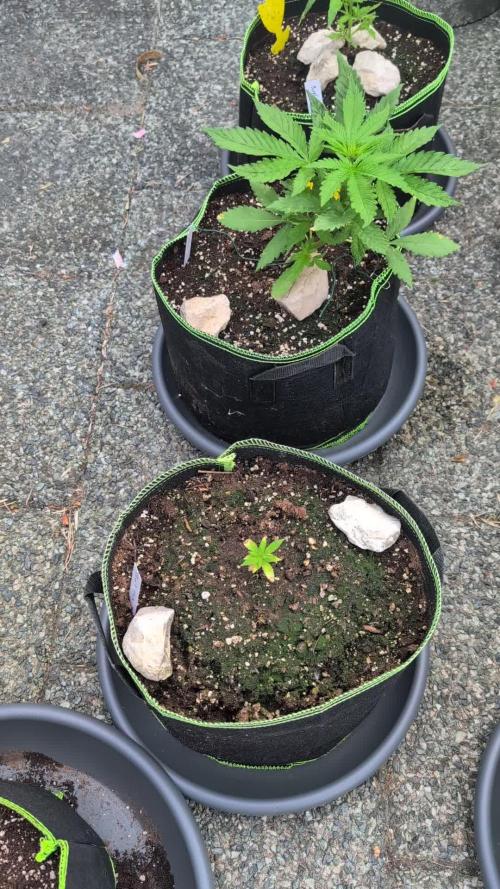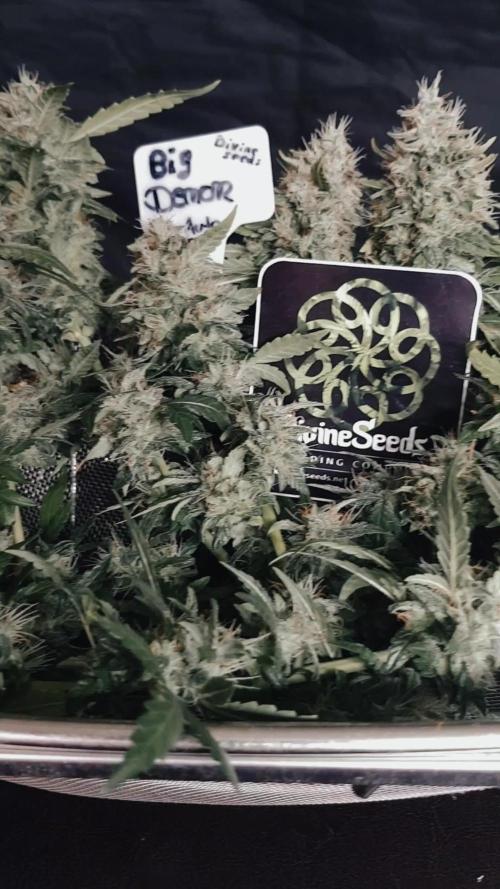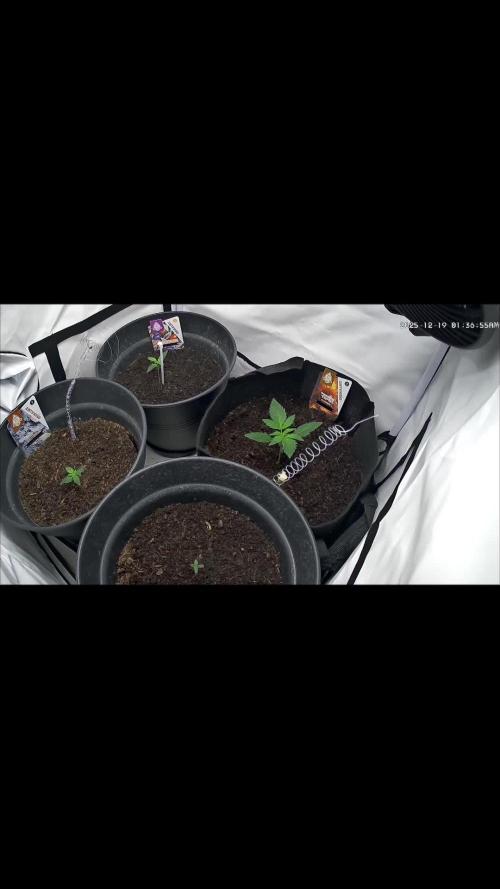The Grow Awards 2026 🏆 



























Likes
4
Share


@JardineiroBr
Follow
Estou com duas plantas una está linda com cerca de 55 cm bem saudável e perfumada , já a outra cresceu mais rápido e estava bem saudável, desde que entrou na flora apresentou uma deficiência que estou tentando suprir com aminoácidos, micro e potássio com enxofre.
Likes
4
Share


@GarciasGarden
Follow
End of week 2 beginning of week 3 the plants were doing well but now we’re seeing some nutrient lockout “we think” there is what looks like nitrogen toxicity with the curled tips and the discoloration of the leaves meaning mag deficiency /calcium .. today I flushed with 5.8-6.0 ph RO water then fed a little feed that at 940 ppm and 6.0 ph really hoping things turn around as of now not seeing any hermies thank god ! The lights were turned up to 70% power and the plants are just about done with their stretch ! The baby buds are looking ok now super bad problems yet . I’m doing this grow all automated so I’m only available to be hands on abojt 2 times a week which is something I’m not used too. Hopefully in the next week we start seeing the plants bouncing back to life ! If you guys could help out and lmk what you think is wrong with the plants when it comes to the discoloration and curled tips please let me know! Temp is 73 during the day 67-68 at night and humidity is between 43-48%
Likes
42
Share


@Pr3m_85
Follow
I'm back to home 🙂 !!! I was hospitalized for my Crohn 😔. The next time, I'm good at having a piece of my stomach cut off ✂️✂️✂️
If not, girls seems to be fine without my presence 🤷🏼🙂.
Peace to all ✌️✌️🏼✌️🏿✌️🏾✌️🏻✌️🏽
Day 36 : flush with ph'd water 💦
Processing
Likes
4
Share


@Ferenc
Follow
Week 10: 20/4 light schedule, 150 mp water per plant 2x, no fertilization anymore. Day 65: Next week Tueasday/beggining week 11/ we need to harvest because they will come from the council to check the house😂 Well, the previous one finished in 69 days, but I think they won't be properly ready by next week. I tried it and made me high anyways. I would give at least 2 weeks more to be done. Tomorrow I will check the trichomes with magnifying glass. They are beautiful stinky girls. Flowers are getting thicker and pistils are getting brownish. Day 66: I checked the trichomes with magnifying glass and it will be ready by next Tuesday. 7 days left with this day. They are beautiful just check in the video (Day 66).
Day 67: It is crazy the last 3 days was so hot here in London. Today was 38 degrees!!!!!! Poor plants even with ventilation it goes up to 30-31 degrees. Well, it is alright because direct ventilation goes on so they won't be cooked. 😓😛 Day 70: It is the last day when they receive water and they just get once and half of the daily intake. 2 days before harvest I will not water them. Harvest day is on Tuesday 30th of July when they are 72 days old. I have checked the trichomes all good they are matured nicely cloudy so now it is very strong. They are very stinky girls 😋 Day 71: No more water for them..... Tomorrow is harvest day!!!!!😋
Likes
14
Share


@GoldenWeedGrower
Follow
D71/F27 - 10/06/23 - Added Nutes and water, EC 1 and pH 5.0
D72/F28 - 11/06/23 - Nothing to report
D73/F29 - 12/06/23 - Added Nutes and water, EC 0.8 and pH 5.3
D74/F30 - 13/06/23 - Nothing to report
D75/F31 - 14/06/23 - Added Nutes and water, EC 0.9 and pH 5.3
D76/F32 - 15/06/23 - 👉Changed Water. Some signals on the leafes. I think it is because of heat but I0m going to ask to the community.
D77/F33 - 16/06/23 - I've asked to the community and is heat stress, so I'm going to change the light hours to 12/24 (4 only red ligh and 8 red-white)
Likes
29
Share


@420DeepGrow
Follow
Gracias al equipo de Sensi Seeds, Marshydro, XpertNutrients y Pro-Mix, sin ellos esto no seria posible.
💐🍁: Mr Nice G13 x Hash Plant:
Las semillas de cannabis Mr Nice G13 x Hash Plant son 100% Indica. La variedad incluye G13 en su genética; una planta afgana de primera calidad que (según la leyenda) fue sacada de contrabando de un centro de investigación del gobierno por un técnico. Sensi Seeds desarrolló la variedad con el objetivo de mejorar aún más la G13 y el resultado fue Mr Nice, que se lanzó en 1999.
Mr Nice G13 x Hash Plant Regular tiene un tiempo de floración de 60 a 65 días.
Como era de esperar, dada su genética índica, esta variedad no alcanza alturas significativas. Sin embargo, cuando se cultiva en exterior, no es raro que las plantas alcancen unos 190 a 240 cm. En interior, son mucho más compactas, y la planta media crece aproximadamente entre 80 y 170 cm.
Mr Nice G13 x Hash Plant Regular proporciona un colocón corporal increíblemente potente. Es 100 % índica y esto se nota en el efecto de "apagón" que produce, ya que los usuarios afirman sentirse muy relajados y aliviados después de consumirla. Gracias a la genética "doble afgana", las plantas producen un aroma terroso y picante. Este aroma tiene un matiz dulce, rico y penetrante, que se intensifica a medida que maduran los cogollos. Al gusto, es casi como una mezcla de ganja y hachís, ya que es excepcionalmente fuerte y rico.
🚀🌻 Consigue aquí tus semillas:
https://sensiseeds.com/en/cannabis-seeds/sensi-seeds/mr-nice-g13-x-hash-plant
💡FC6500: Eficiencia líder en el mercado: la lámpara de cultivo LED FC-E6500, que ostenta un estatus líder en el mercado, es una solución rentable con un PPE de 2,8 µmol/J y un rendimiento máximo de 2,5 g/vatio. Ofrece un PPF alto de 2026 umol/S y es adecuada para una cobertura de vegetación de 1,50 m x 1,50 m y una cobertura de flores de 1,20 m x 1,20 m.
Iluminación versátil y uniforme.
https://marshydro.eu/products/mars-hydro-fc-e-6500-730w-commercial-led-grow-light/?gad_source=1&gclid=Cj0KCQjw1qO0BhDwARIsANfnkv9IIrYSbmJqz8PqpJOIyWwJfp5bc3SGJgUV68USLQ4tjmXDYwoBuAsaAue3EALw_wcB
🚥 MarsHydro ADLITE UV/IR/RED:
Para lograr un crecimiento óptimo de las plantas y maximizar los rendimientos es un arte simple que depende en gran medida de las condiciones ambientales adecuadas. Reconociendo las limitaciones de la iluminación natural y las soluciones de iluminación tradicionales para satisfacer estas necesidades únicas, lanzamos ADLITE. Estas luces especiales UV, IR y roja están diseñadas para llenar áreas del espectro, proporcionando las altas longitudes de onda que las plantas necesitan para un crecimiento y desarrollo óptimos.
Consigue aqui tu Adlite:
https://marshydro.eu/collections/adlite-supplemental-lights/
🏠 : Marshydro 1.50 x 1.50 x 1.80, carpa 100% estanca con ventanas laterales para llegar a todos los lugares durante el grow
https://marshydro.eu/products/diy-150x150x200cm-grow-tent-kit
🌬️💨 Marshydro 6inch + filtro carbon para evitar olores indeseables.
https://marshydro.eu/products/ifresh-smart-6inch-filter-kits/
🍣🍦🌴 Xpert Nutrients es una empresa especializada en la producción y comercialización de fertilizantes líquidos y tierras, que garantizan excelentes cosechas y un crecimiento activo para sus plantas durante todas las fases de cultivo.
Consigue aqui tus Nutrientes:
https://xpertnutrients.com/es/shop/
📆 Semana 5:
Una vez terminada la fase de estiramiento dedican todo su esfuerzo a crear nuevos pistilos y resina, es hora de engordar estos futuros cogollos.
La carpa esta totalmente cubierta gracias al FC-6500 y los Adlite de Marshydro, se nota la floración mas avanzada que otras veces y con una mayor densidad.
Continuo con las dosis de nutrientes recomendadas por XpertNutrients.
Likes
3
Share


@Krautbauern
Follow
On some pics you can see the orange trichomes so its getting time for the harvest soon.
At D45 we stop fertilizing, now they will only get tap water (-pH) for the last 5 days, after that they will get 2 days of darkness
Likes
4
Share


@Nargileus
Follow
Teilweise war es sehr regnerisch aber den Pflanzen hat es nicht geschadet, die kleine von der ich gedacht habe das sie stirbt fängt langsam an zu wachsen. Normaler weise würde man die beiden kleinen Krüppel ja gegen neue austauschen, aber ich möchte sehen was daraus wird.
Likes
110
Share


@SlowpokeFuegobud
Follow
💜 💚 😍🥤💜💜 💚 😍🥤💜💜 💚 😍🥤💜💜 💚 😍🥤💜💜 💚 😍🥤💜
Dear growmies, welcome to the Purple Lemonade Fast Flowering diary!! ❤️
The little seed popped the fastest of all the seeds of this run! 🏆 Vigorous!!
Can't wait for this journey! 😍
DAY 1
Soaked the seeds in Humic Acid for 2 hrs, then used some of it to pimp the water and soak the paper towels. 💧
Thanks @Fast_Buds for your awesome genetics, growing Fastbuds is always a bit like riding a ferris wheel! Woohooo!! 😜 🙏 💚
Thanks to my sponsors @Green_Buzz_Nutrients, their nutes never ever let me down!! Check out my diaries on how well they work! 💚 😘 In case you want to give them a try, you can find a generous discount code in the setup description further down the road ⬇️
You can find more brand hot updates on my IG, where I share real time events from my growroom, don't miss this! 😝
_______________________________________________________________________
Purple Lemonade FF
As refreshing as cold lemonade on a hot Summer day. 🌞
• Quench your thirst. Just as good as lemonade on a hot Summer day.
• The gentle giant. Up to 550 g/m2 of gorgeous pinkish-purple buds.
• Refreshing for the mind and body. The ideal all-day strain with a perfectly balanced effect.
• Sweet n’ sour terps. Mouth-puckering lemon flavors that’ll hypnotize your taste buds.
• Properly purple. The perfect choice for purple hash and extractions.
Arising from a cross between purple and citrus Cali genetics, Purple Lemonade FF (Fast Flowering) offers a complex high made up of perfectly balanced cerebral and body effects that are ideal for daytime use. Expect an extremely enjoyable high that boosts your mood while deeply relaxing your whole body and getting
rid of muscle pain. This meticulous cross produces up to 550 g/m2 of some of the most beautiful purple buds, with pinkish and reddish hues that will catch everyone’s attention. The beautiful purple buds are ready for harvest in 7-8 weeks and come hand-in-hand with unbelievably sugary citrus terps that are just as refreshing as a cold lemonade on a hot Summer day. It’s the ideal variety for the sweet-tooth stoner seeking strains that deliver both in quality and quantity of resin.
Bud Description 🦔
Purple Lemonade FF grows chunky, spade-shaped buds that boast a whole range of pinkish-purple hues with rich, dark orange pistils shooting out of every direction. This variety stands out for the, oftentimes, lilac trichomes that give them a gorgeous pink tint and make for outstanding purple concentrates. The buds give off a delicious tart lemon aroma that reveals a sweeter, more fruity scent as you break the buds open. Definitely a must for flavor chasers and those looking for pungent terpene profiles.
Smoke Reports 💨
Purple Lemonade FF offers an effect that’s just as unique as the flavor. Expect a potent uplifting high that gives you that energy boost you need to get things done while 100% happy and stress-free. The effect gradually transforms into a wave that works its way along the limbs and through the muscles, deeply relaxing your body and putting you in the right mindset to go through a busy day with a huge smile on your face. This is an excellent all-day smoke as it not only increases energy but can also help combat chronic pain, migraine and stress.
Plant Appearance 💄
This feminized photoperiod variety develops a thick and strong structure, growing a medium-sized main cola with multiple shorter side branches, typical of hybrid strains. Purple Lemonade FF develops fairly short internodal spacing with gorgeous purple buds growing stacked on top of each other, making it the perfect choice for growers of all levels looking to get lots and lots of top-shelf purple weed, as this variety can produce up to 550 g/m2 in a 7-8 week flower cycle.
Grow Tips 🤓
This is a super fast feminized photoperiod version that takes approximately 7-8 weeks to flower with a 5-week vegetation cycle,, this means you can have faster harvests by shortening the veg cycle or have a longer veg cycle for bigger yields. Purple Lemonade FF (Fast Flowering) makes for a great candidate for growers of all levels as it’s a vigorous strain that will thrive with basic maintenance both indoors and outdoors. This is a resin powerhouse so make sure to have your trim bin close by as all the resinous sugar leaves will make for the most mouth- watering hash and extracts.
Flavor 😋
Expect a long-lasting citrus zest that taste just like it smells. Purple Lemonade FF reeks of a delicious blend of sweet fruits and tart citrus that’ll make your mouth water. On the inhale, expect sour flavors that taste just like lemon candy with hints of orange and a really subtle earthy background. And on the exhale, the citrus flavors open up, giving place to a more sugary berry fruitiness that leaves your whole mouth tasting like an extremely sweet weed-infused lemonade.
https://2fast4buds.com/seeds/purple-lemonade-fast-flowering
_______________________________________________________________
Setup:
140x70x200 cm Spiderfarmer tent
2x Monkey 16W fans (not oscillating)
1x Secret Jardin 30W
1x box fan 50W oscillating (on lowest level)
LED
Full Spectrum 320W AGLEX AGL-320W-MA
5,6 kg
foldable, dimmable
864 pieces Samsung LH301H
864umol/s
2,7umol/J
full spectrum white + RED 660nm + IR 740nm
wavelength range 380-780nm
covering 3x4ft
Green Buzz Nutrients https://greenbuzzliquids.com/
❗ Use code GD42025 for generous 25% discount (for orders of minimum 75€)
Biobizz Lightmix + coco + wormcastings + perlite
Carbon Active Granulate Filter 125/360 cm³/h
PrimaKlima exhaust EC 125-400/240 cm³/h
Likes
15
Share


@GERGrowDesigns
Follow
Welcome to Flower Week 7-8 and Harvest
of Divine Seeds Auto Big Demon
I'm excited to share my grow journey with you all as part of the Divine Seeds Autoflowering Competition 2025. It's going to be an incredible ride, full of learning, growing, and connecting with fellow growers from all around the world!
For this competition, I’ve chosen the Feminized Automatic strain: Big Demon
Here’s what I’m working with:
• 🌱 Tent: 120x60x80
• 🧑🌾 Breeder Company: Divine Seeds
• 💧 Humidity Range: 50
• ⏳ Flowering Time: 8W-10W
• Strain Info: 21-23%THC
• 🌡️ Temperature: 26
• 🍵 Pot Size: 0.5l
• Nutrient Brand: Narcos
• ⚡ Lights : 200W x 2
A huge thank you to Divine Seeds for allowing me to be a part of this amazing competition and Sponsoring the Strains. Big thanks for supporting the grower community worldwide! Your genetics and passion speak for themselves!
I would truly appreciate every bit of feedback, help, questions, or discussions – and of course, your likes and interactions mean the world to me as I try to stand out in this exciting competition!
Let’s grow together – and don’t forget to stop by again to see the latest updates!
Happy growing!
Stay lifted and stay curious!
Peace & Buds!
Likes
48
Share


@Theia
Follow
I am not sure what the deal is with the Chibans. They look mutant to me maybe due to pollination. There is so much crystal forming up on them and they still look beautiful.
Plant 1 is huge with big colas that are fragrant and very very sticky to the touch.
Plant 2 looks the most normal as far as bud structure to me. She has not got the same flattened of tops but instead are more cone like . Also very very crystal heavy
Clones 1 and 2 look like monsters to me. Their buds are bulbous and fat with a very flat round top and quite a bit larger then golf balls! I have never seen bud look like this but then I have never had pollination issues and watched the plants quite as much as I am at the moment.
We will keep going with them and see what we get. I hope for some smokable bud and also some Sherbert banana seeds maybe🤪👍👍.
Thanks for looking.
Stay safe.
Grow well.🌱🌱
Likes
59
Share


@Salokin
Follow
These ladies continue to develop very nicely and lucky stopped stretching pretty much in the beginning of this week and the buds are forming super nicely. Since I also don’t observe a stretch in flower anymore, I decided to feed pk13/14 for the next week. It continues to surprise me how hungry these autos are, much hungrier than my glookies fro example. Unfortunately I realized that the plant on the very right of the box produces much smaller buds than the other two. I am pinning that on the fan right above her, so have pointed it slightly higher, but I guess the damage is done:(.
Likes
52
Share


@wolfvb
Follow
The second weeks starts and the ladies are doing great, the Pineapple Express is a beast she is growing really well.
The blue cheese and the white runtz are also doing okay, I would not compare them with the her though.
They been really easy to take care of so far.
Let’s see how this will go on the next days.
21.12.2025
The girls are doing really good 😊.
Noticed the my tent sensors is 4 degrees of when it come to humidity. So I updated my humidity control automation to increase humidity a bit more.
And moved the fan to the other side so the big girl get extra air flow and now she is dancing 😋
22.12.2025
The girls seems really happy today I will give a break and let them be no water tell the soil is dry and let's see how they react
Likes
11
Share


@Skunkiest_bender39
Follow
Habe Wärme Matte untergelegt um die Temperatur zwischen 16-24 zu halten. Leichte Sprünge zwischen den Blütenständen denke ist auf den Kältestress zurückzuführen. Habe licht voll aufgedreht, hat den Sprung nur noch mehr gefördert, jetzt wieder 80% und Wärme von unten. Letzte Woche läuft an!

























